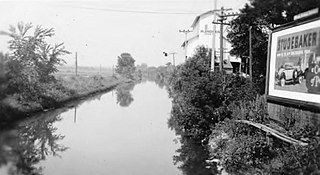
The Illinois and Michigan Canal connected the Great Lakes to the Mississippi River and the Gulf of Mexico. In Illinois, it ran 96 miles (154 km) from the Chicago River in Bridgeport, Chicago to the Illinois River at LaSalle-Peru. The canal crossed the Chicago Portage, and helped establish Chicago as the transportation hub of the United States, before the railroad era. It was opened in 1848. Its function was largely replaced by the wider and shorter Chicago Sanitary and Ship Canal in 1900, and it ceased transportation operations with the completion of the Illinois Waterway in 1933.
The National Register of Historic Places (NRHP) is the United States federal government's official list of districts, sites, buildings, structures and objects deemed worthy of preservation for their historical significance. A property listed in the National Register, or located within a National Register Historic District, may qualify for tax incentives derived from the total value of expenses incurred in preserving the property.
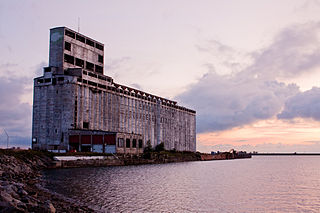
A grain elevator is an agrarian facility complex designed to stockpile or store grain. In grain trade, the term "grain elevator" also describes a tower containing a bucket elevator or a pneumatic conveyor, which scoops up grain from a lower level and deposits it in a silo or other storage facility.

The National Register of Historic Places in the United States is a register including buildings, sites, structures, districts, and objects. The Register automatically includes all National Historic Landmarks as well as all historic areas administered by the U.S. National Park Service. Since its introduction in 1966, more than 90,000 separate listings have been added to the register.

Buildings, sites, districts, and objects in New York listed on the National Register of Historic Places:
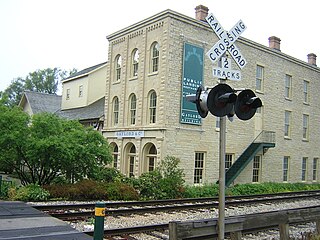
The Gaylord Building, constructed in 1838 in the downtown historic district of Lockport, Illinois, and on the canalside there, played a pivotal role in the construction of the Illinois and Michigan Canal. It is on the United States National Register of Historic Places, and is one of 29 Historic Sites of the National Trust for Historic Preservation. It is constructed of yellow limestone, a common construction material in north central Illinois. It has an Italianate three story addition added in 1859. After falling into disrepair, it was the focus of a concerted restoration and preservation effort that began in 1983, which was later noted as setting a model for such efforts.

The Chicago Great Western Railroad Depot is a historic railway station in the village of Elizabeth, Illinois, USA. It was built in 1877–78 and like many rural stations along the Chicago Great Western Railroad it was cast in Stick style. The building was listed on the U.S. National Register of Historic Places in 1996.

The Scales Mound Historic District is a historic district in the small Illinois village of Scales Mound. The district encompasses the entire corporate limit of the village and has more than 200 properties within its boundaries. The district was added to the U.S. National Register of Historic Places in 1990.

The Chicago, Rock Island and Pacific Depot in Marseilles, Illinois is a historic train station built in 1917. It was in operation as a rail depot until 1974. The depot was added to the U.S. National Register of Historic Places in 1995.

Concrete-Central Elevator is a historic grain elevator located on the Buffalo River at 175 Buffalo River Buffalo in Erie County, New York.

Prairie Avenue is a north–south street on the South Side of Chicago, which historically extended from 16th Street in the Near South Side to the city's southern limits and beyond. The street has a rich history from its origins as a major trail for horseback riders and carriages. During the last three decades of the 19th century, a six-block section of the street served as the residence of many of Chicago's elite families and an additional four-block section was also known for grand homes. The upper six-block section includes part of the historic Prairie Avenue District, which was declared a Chicago Landmark and added to the National Register of Historic Places.
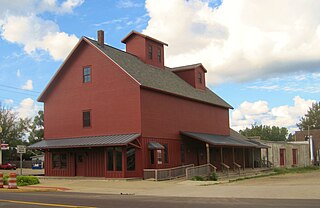
The Bangor Elevator is a grain elevator located at 142 West Monroe Street in Bangor, Michigan. It was listed on the National Register of Historic Places in 2009.

Hoots Milling Company Roller Mill, also known as Charles A. Bunn Company Office and Warehouse, is a historic roller mill and warehouse located at Winston-Salem, Forsyth County, North Carolina. The mill was built about 1935, and is a two-story heavy timber and frame building, with an attached two-story heavy timber and frame warehouse built about 1937. A one-story, metal-sided, front-gable-roofed, warehouse was built in the 1930s. A one-story warehouse added in the 1950s connected the two buildings. The mill incorporates a gabled grain elevator.

Dart's Elevator was the world's first steam-powered grain elevator. It was designed and built by Joseph Dart and Robert Dunbar in 1842 in Buffalo, New York. The elevator burned in the 1860s.

George Armour was a Scottish American businessman and philanthropist known for his contributions to the global distribution process for commodities. He is credited with developing the grain elevator system, establishing grain trading standards as director and president of the Chicago Board of Trade (CBT), founding the Chicago, Burlington and Quincy Railroad (CBQ), Commercial Club of Chicago, YMCA of Chicago, Merchants' Loan & Trust Company (MLTC), the precursor to Continental Illinois, and the Chicago Academy of Fine Arts which later became the School of the Art Institute of Chicago and Art Institute of Chicago. He served as a director of several notable companies during his career.

The Potter and Barker Grain Elevator is a historic grain elevator located at 1N298 La Fox Road in La Fox, Illinois. The elevator was built in 1868 by former whaling ship captain Lemuel Potter and his brother-in-law Henry Barker. Part of a wave of industrial development in the Fox Valley, it served as a transfer point for grain being shipped along the Galena and Chicago Union Railroad. The elevator represents an intermediate point in the transition from one-story rural elevators to taller, mechanized second stage elevators. Its small capacity is typical of the older one-story elevators, but it includes mechanized systems of unloading and raising grain common to later structures.

The Ross Grain Elevator is a historic building located in Ross, Iowa, United States. It was built in 1881 by Charles Stuart, a Civil War veteran who was a forwarding agent for the Chicago and Northwestern Railroad. The wooden structure rests on a limestone foundation. By the early 20th century the elevator was sheathed in corrigated steel to guard against the sparks that came off of the locomotives at the nearby depot, no longer extant. The elevator is made up of three interconnected buildings that include the elevator itself, an annex, and the brick scale-engine house. At one time the property contained two grain elevators, a depot, stock yards, cob houses, town dump, coal shed and other related structures. The railroad discontinued operations here in the 1940s, and the other buildings were removed over the years. The elevator itself was used on a farm into the 1970s. It has not been used since then, but its internal mechanisms are still extant. The elevator was listed on the National Register of Historic Places in 2018.

The Vermont House and Fenton Grain Elevator are two adjacent buildings located at 302 and 234 North Leroy Street in Fenton, Michigan. They were listed on the National Register of Historic Places in 1980.
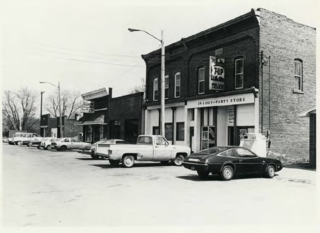
The Genesee Avenue–Walker Street Historic District is a primarily commercial- and railroad-oriented historic district, located along three blocks of Walker Street and one intersecting block of Genesee Avenue in Gaines, Michigan. It was listed on the National Register of Historic Places in 1983.





















